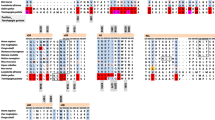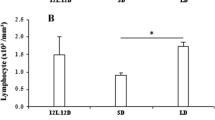Abstract
Corticotropin-releasing hormone- and cortisol-like molecules are present in the haemocytes of different molluscan species and in the epithelial cells, interdigitating cells and macrophages -- but not in the lymphocytes -- of fish, frog, chicken and rat thymus. Taking into account the fact that other pro-opiomelanocortin-derived peptides, such as adrenocorticotropin hormone, are present in the haemocytes and thymus of the same species, these results complete the list of stress mediators present in molluscan haemocytes and further support the hypothesis that, although the prototype stress response we have demonstrated in invertebrates is concentrated in a single cell, i.e. the haemocyte, it is similar to the response seen in vertebrates. Moreover, the data presented here are compatible with the hypothesis that an evolutionary, conserved stress response can occur locally with a single organ, e.g. the thymus, in which all the main mediators of this biological response, such as corticotropin-releasing hormone, adrenocor ticotropin hormone and glucocorticoids, are present. The implications of these findings for the physiology of thymus and stress response may be far reaching. © 1998 Chapman & Hall
Similar content being viewed by others
References
Aird, F., Clevenger, C.V., Prystowsky, M.B. & Redei, E. (1993) Corticotropin-releasing factor mRNA in rat thymus and spleen. Proc. Natl. Acad. Sci. USA 90, 7104-8.
Bidmon, H.-J. & Stumpf, W.E. (1991) Uptake, distribution and binding of vertebrate and invertebrate steroid hormones and time dependence of ponasterone A binding in Calliphora vicina. Comparisons among cholesterol, corticosterone, cortisol, dexamethasone, 5α-dihydrotestosterone, 1,25-dihydroxyvitamin D3, ecdysone, estradiol-17β, ponasterone A, progesterone, and testosterone. Histochemistry 96, 419-34.
Bradbrook, D.A., Clement, C.Y., Cook, B. & Dinan, L. (1990) The occurence of vertebrate-type steroids in insects and a comparison with ecdysteroid levels. Comp. Biochem. Physiol. 95B, 365-74.
Burns, B.G., Sangalang, G.B., Freeman, H.C. & McMeneny, M. (1984) Isolation and identification of testosterone from the serum and testes of the American lobster (Homarus americanus). Gen. Comp. Endocrinol. 54, 429-32.
Chapman, J.C., Lokley, W. S., Rees, H.H. & Goodwin, T.W. (1977) Stereochemistry of olefinic bond formation in defensive steroids of Acilius sulcatus (Dytiscidae). Eur. J. Biochem. 81, 293-8.
Donaldson, E.M. (1981) In Stress and Fish (edited by Pickering, A.D.), pp. 11-47. New York: Academic Press.
Franchini, A., Ottaviani, E. & Franceschi, C. (1995) Presence of immunoreactive pro-opiomelanocortin-derived peptides and cytokines in the thymus of an anuran amphibian (Rana esculenta). Tissue Cell 27, 263-7.
Fryer, N. & Peter, R.E. (1977) Hypothalamic control of ACTH secretion in goldfish. I. Corticotropin-releasing factor activity in teleost brain tissue extracts. Gen. Comp. Endocrinol. 33, 196-201.
Hane, S. & Robertson, O.H. (1959) Changes in plasma 17-hydroxycorticosteroids accompanying sexual maturation and spawning of the Pacific salmon (Oncorhynchus tshawytsha) and rainbow trout (Salmo gairdneri). Proc. Natl. Acad Sci. USA 45, 886-93.
Hsu, S.M., Raine, L. & Fanger, H. (1981) Use of avidin- biotin-peroxidase complex (ABC) immunoperoxidase techniques: a comparison between ABC and unlabeled antibody (PAP) procedures. J. Histochem. Cytochem. 29, 577-80.
Meinwald, J., Roach, B., Hisks, K., Alsop, D. & Eisner, T. (1985) Defensive steroids from a carrion beetle (Silpha americana). Experientia 41, 516-9.
Novak, F., de Clerk, D., Paesen, G., Swevers, L. & De Loof, A. (1987) Radioimmunological quantification of C21, C19 and C18 steroids in haemolymph of the insect Locusta migratoria. Int. J. Invert. Reprod. Dev. 11, 255-64.
Ottaviani, E. & Franceschi, C. (1993) The common evolutive origin of the immune and neuroendocrine systems. Facts and speculations. Minerva Biotec. 5, 82-90.
Ottaviani, E. & Franceschi, E. (1996) The neuroimmunology of stress from invertebrates to man. Prog. Neurobiol. 48, 421-40.
Ottaviani, E., Caselgrandi, E., Petraglia, F. & Franceschi, C. (1992) Stress response in the freshwater snail Planorbarius corneus (L.) (Gastropoda, Pulmonata): interaction between CRF, ACTH and biogenic amines. Gen. Comp. Endocrinol. 87, 354-60.
Ottaviani, E., Caselgrandi, E., Franchini, A. & Franceschi, C. (1993) CRF provokes the release of norepinephrine by hemocytes of Viviparus ater (Gastropoda, Prosobranchia): further evidence in favour of the evolutionary hypothesis of the ‘mobile immunebrain’. Biochem. Biophys. Res. Commun. 193, 446-52.
Ottaviani, E., Franchini, A., Caselgrandi, A., Cossarizza, A & Franceschi, C. (1994) Relationship between corticotrophin-releasing factor and interleukin-2: evolutionary evidence. FEBS Lett. 351, 19-21.
Ottaviani, E., Franchini, A. & Franceschi, C. (1995) Evidence for the presence of immunoreactive POMC-derived peptides and cytokines in the thymus of the goldfish (Carassius c. auratus). Histochem. J. 27, 597-601.
Ottaviani, E., Franchini, A. & Franceschi, C. (1997a) Pro-opiomelanocortin-derived peptides, cytokines, and nitric oxide in immune responses and stress: an evolutionary approach. Int. Rev. Cytol. 170, 79-141.
Ottaviani, E., Franchini, A. & Franceschi, C. (1997b) Evolution of neuroendocrine thymus: studies on POMC-derived peptides, cytokines and apoptosis in lower and higher vertebrates. J. Neuroimmunol. 72, 67-74.
Putti, R., Franchini, A. & Ottaviani, E. (1992) International Symposium on 'Stress: the Neuropeptide Perspective', pp. 36-7. Rimini, Italy.
Redei, E. (1992) Immuno-reactive and bioactive cortico-tropic-releasing factor in rat thymus. Neuroendocrinology 55, 115-8.
Vacchio, M.S., Papadopoulos, V. & Ashwell, D. (1994) Steroid production in the thymus: implications for thymocyte selection. J. Exp. Med. 179, 1835-46.
Weigent, D.A. & Blalock, E. (1987) Interaction between the neuroendocrine and immune systems: common hormones and receptors. Immunol. Rev. 100, 79-108.
Weigent, D.A. & Blalock, E. (1989) Structural and functional relationships between the immune and neuroendocrine system. Bull. Inst. Pasteur 87, 61-92.
Author information
Authors and Affiliations
Rights and permissions
About this article
Cite this article
Ottaviani, E., Franchini, A. & Franceschi, C. Presence of immunoreactive corticotropin-releasing hormone and cortisol molecules in invertebrate haemocytes and lower and higher vertebrate thymus. Histochem J 30, 61–67 (1998). https://doi.org/10.1023/A:1003270614163
Issue Date:
DOI: https://doi.org/10.1023/A:1003270614163




